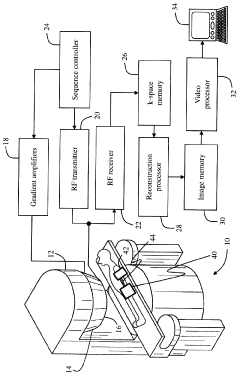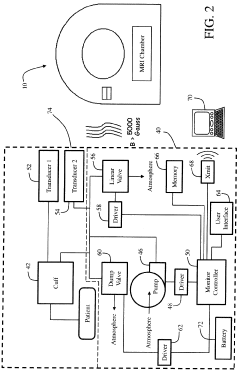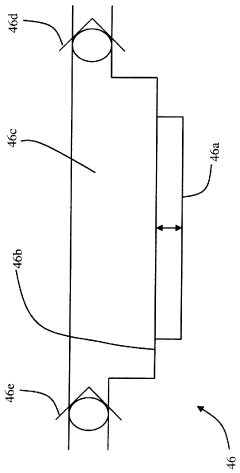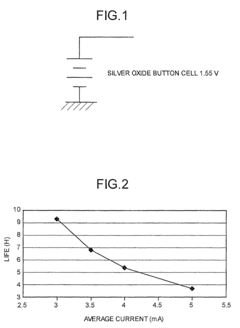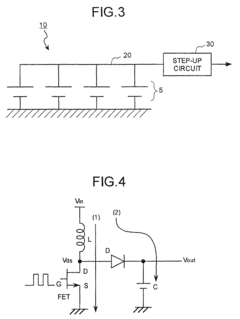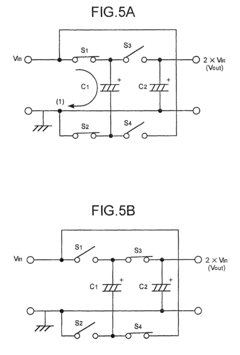Innovations in laryngoscope power source management.
JUL 14, 20259 MIN READ
Generate Your Research Report Instantly with AI Agent
Patsnap Eureka helps you evaluate technical feasibility & market potential.
Laryngoscope Power Evolution
The evolution of laryngoscope power sources has been a critical aspect of medical device innovation, significantly impacting the efficiency and reliability of these essential tools in airway management. Initially, laryngoscopes relied on disposable alkaline batteries, which were prone to unexpected power failures and environmental concerns due to frequent replacements.
The advent of rechargeable batteries marked a significant milestone in laryngoscope power evolution. Nickel-cadmium (NiCd) batteries were among the first rechargeable options, offering improved reliability and reduced waste. However, their memory effect and environmental hazards led to the adoption of nickel-metal hydride (NiMH) batteries, which provided higher energy density and eliminated the memory effect issue.
Lithium-ion (Li-ion) batteries represented the next major leap in laryngoscope power technology. Their high energy density, longer lifespan, and lack of memory effect made them ideal for medical devices. This transition allowed for the development of more compact and lightweight laryngoscopes without compromising on power output or operational duration.
Recent innovations have focused on optimizing power management systems within laryngoscopes. Smart battery management systems have been integrated, enabling real-time monitoring of battery health, charge levels, and performance. These systems can predict battery life more accurately, reducing the risk of unexpected power loss during critical procedures.
Wireless charging technology has also been incorporated into modern laryngoscopes, eliminating the need for direct electrical connections and reducing the risk of contamination. This advancement has simplified the recharging process and improved the overall hygiene of the devices in clinical settings.
Energy harvesting techniques are emerging as a potential future direction for laryngoscope power sources. Research is being conducted on harnessing kinetic energy from the device's movement or thermal energy from the user's hand to supplement battery power, potentially extending operational time between charges.
The integration of low-power LED technology has significantly reduced the energy consumption of laryngoscopes, allowing for longer operation times and smaller battery sizes. This has led to the development of more ergonomic designs and improved maneuverability during intubation procedures.
As sustainability becomes increasingly important, there is a growing focus on developing eco-friendly power solutions for laryngoscopes. This includes the use of biodegradable materials in battery construction and the implementation of more efficient recycling processes for used power sources.
The ongoing evolution of laryngoscope power sources continues to drive improvements in device reliability, usability, and environmental impact. Future developments are likely to focus on further enhancing energy efficiency, exploring alternative power generation methods, and refining power management systems to meet the demanding requirements of modern medical practice.
The advent of rechargeable batteries marked a significant milestone in laryngoscope power evolution. Nickel-cadmium (NiCd) batteries were among the first rechargeable options, offering improved reliability and reduced waste. However, their memory effect and environmental hazards led to the adoption of nickel-metal hydride (NiMH) batteries, which provided higher energy density and eliminated the memory effect issue.
Lithium-ion (Li-ion) batteries represented the next major leap in laryngoscope power technology. Their high energy density, longer lifespan, and lack of memory effect made them ideal for medical devices. This transition allowed for the development of more compact and lightweight laryngoscopes without compromising on power output or operational duration.
Recent innovations have focused on optimizing power management systems within laryngoscopes. Smart battery management systems have been integrated, enabling real-time monitoring of battery health, charge levels, and performance. These systems can predict battery life more accurately, reducing the risk of unexpected power loss during critical procedures.
Wireless charging technology has also been incorporated into modern laryngoscopes, eliminating the need for direct electrical connections and reducing the risk of contamination. This advancement has simplified the recharging process and improved the overall hygiene of the devices in clinical settings.
Energy harvesting techniques are emerging as a potential future direction for laryngoscope power sources. Research is being conducted on harnessing kinetic energy from the device's movement or thermal energy from the user's hand to supplement battery power, potentially extending operational time between charges.
The integration of low-power LED technology has significantly reduced the energy consumption of laryngoscopes, allowing for longer operation times and smaller battery sizes. This has led to the development of more ergonomic designs and improved maneuverability during intubation procedures.
As sustainability becomes increasingly important, there is a growing focus on developing eco-friendly power solutions for laryngoscopes. This includes the use of biodegradable materials in battery construction and the implementation of more efficient recycling processes for used power sources.
The ongoing evolution of laryngoscope power sources continues to drive improvements in device reliability, usability, and environmental impact. Future developments are likely to focus on further enhancing energy efficiency, exploring alternative power generation methods, and refining power management systems to meet the demanding requirements of modern medical practice.
Market Demand Analysis
The market demand for innovations in laryngoscope power source management has been steadily increasing, driven by the growing emphasis on patient safety, operational efficiency, and sustainability in healthcare settings. Healthcare providers are increasingly seeking laryngoscopes with improved power management systems that offer longer battery life, faster charging capabilities, and enhanced reliability during critical procedures.
One of the primary factors fueling this demand is the rising number of surgical procedures worldwide. As the global population ages and chronic diseases become more prevalent, the need for intubation and other procedures requiring laryngoscopes continues to grow. This trend is particularly evident in emerging markets, where healthcare infrastructure is rapidly expanding, creating new opportunities for advanced medical devices.
The COVID-19 pandemic has further accelerated the demand for innovative laryngoscope power solutions. The increased focus on infection control and the need for quick, efficient intubation in emergency situations have highlighted the importance of reliable, long-lasting power sources for these critical devices. Healthcare facilities are now prioritizing laryngoscopes with power management systems that minimize the need for frequent battery changes or recharging, reducing the risk of cross-contamination and ensuring uninterrupted availability during prolonged use.
Sustainability concerns are also shaping market demand. Hospitals and clinics are increasingly adopting environmentally friendly practices, driving interest in rechargeable and energy-efficient power solutions for medical devices, including laryngoscopes. This shift is not only motivated by environmental considerations but also by the potential for long-term cost savings associated with reduced battery waste and replacement expenses.
The market is witnessing a growing preference for integrated power management systems that offer real-time monitoring of battery status, predictive maintenance capabilities, and compatibility with hospital-wide device management platforms. These features allow healthcare providers to optimize device utilization, reduce downtime, and improve overall operational efficiency.
Additionally, there is an increasing demand for power solutions that can support advanced laryngoscope functionalities, such as high-definition video capabilities and wireless connectivity. As laryngoscopes evolve to incorporate more sophisticated technologies, the power requirements become more complex, necessitating innovative approaches to energy storage and management.
The market size for laryngoscope power source innovations is closely tied to the overall laryngoscope market, which is projected to experience significant growth in the coming years. This growth is driven by factors such as technological advancements, increasing prevalence of chronic respiratory diseases, and the expanding geriatric population globally.
One of the primary factors fueling this demand is the rising number of surgical procedures worldwide. As the global population ages and chronic diseases become more prevalent, the need for intubation and other procedures requiring laryngoscopes continues to grow. This trend is particularly evident in emerging markets, where healthcare infrastructure is rapidly expanding, creating new opportunities for advanced medical devices.
The COVID-19 pandemic has further accelerated the demand for innovative laryngoscope power solutions. The increased focus on infection control and the need for quick, efficient intubation in emergency situations have highlighted the importance of reliable, long-lasting power sources for these critical devices. Healthcare facilities are now prioritizing laryngoscopes with power management systems that minimize the need for frequent battery changes or recharging, reducing the risk of cross-contamination and ensuring uninterrupted availability during prolonged use.
Sustainability concerns are also shaping market demand. Hospitals and clinics are increasingly adopting environmentally friendly practices, driving interest in rechargeable and energy-efficient power solutions for medical devices, including laryngoscopes. This shift is not only motivated by environmental considerations but also by the potential for long-term cost savings associated with reduced battery waste and replacement expenses.
The market is witnessing a growing preference for integrated power management systems that offer real-time monitoring of battery status, predictive maintenance capabilities, and compatibility with hospital-wide device management platforms. These features allow healthcare providers to optimize device utilization, reduce downtime, and improve overall operational efficiency.
Additionally, there is an increasing demand for power solutions that can support advanced laryngoscope functionalities, such as high-definition video capabilities and wireless connectivity. As laryngoscopes evolve to incorporate more sophisticated technologies, the power requirements become more complex, necessitating innovative approaches to energy storage and management.
The market size for laryngoscope power source innovations is closely tied to the overall laryngoscope market, which is projected to experience significant growth in the coming years. This growth is driven by factors such as technological advancements, increasing prevalence of chronic respiratory diseases, and the expanding geriatric population globally.
Power Source Challenges
Laryngoscopes, essential tools in medical procedures, face significant challenges in power source management. The primary issue lies in the need for reliable, long-lasting, and efficient power sources that can withstand the demanding environment of medical settings. Traditional battery-powered laryngoscopes often suffer from unexpected power failures during critical procedures, posing serious risks to patient safety.
One of the key challenges is the limited battery life of conventional laryngoscopes. Medical professionals frequently encounter situations where the device's power depletes mid-procedure, necessitating urgent battery replacements. This not only disrupts the workflow but also increases the potential for complications during intubation or examination processes.
Another pressing concern is the environmental impact of disposable batteries. The healthcare industry's reliance on single-use power sources contributes significantly to electronic waste, raising sustainability issues. This has led to a growing demand for more eco-friendly power solutions that can reduce the carbon footprint of medical devices.
The size and weight constraints of laryngoscopes present another hurdle in power source innovation. As these devices need to be compact and lightweight for ease of use, integrating larger or heavier power sources is not a viable option. This limitation challenges engineers to develop power solutions that are both compact and high-capacity.
Sterilization requirements further complicate power source management. Laryngoscopes must undergo rigorous cleaning and sterilization processes, which can be detrimental to many traditional power sources. Developing power solutions that can withstand these harsh conditions without compromising performance or lifespan is a significant technical challenge.
The variability in usage patterns also poses difficulties in power management. Laryngoscopes may be used frequently in some settings, while remaining idle for extended periods in others. This inconsistent usage pattern demands power sources that can maintain charge over long periods of inactivity while also providing quick, reliable power when needed.
Lastly, the cost factor cannot be overlooked. While advanced power solutions might offer improved performance and longevity, they often come with higher price tags. Balancing the need for innovative power sources with cost-effectiveness is crucial for widespread adoption in healthcare settings, especially in resource-constrained environments.
These challenges collectively drive the need for innovative approaches to laryngoscope power source management, pushing researchers and engineers to explore new technologies and strategies to enhance the reliability, efficiency, and sustainability of these critical medical devices.
One of the key challenges is the limited battery life of conventional laryngoscopes. Medical professionals frequently encounter situations where the device's power depletes mid-procedure, necessitating urgent battery replacements. This not only disrupts the workflow but also increases the potential for complications during intubation or examination processes.
Another pressing concern is the environmental impact of disposable batteries. The healthcare industry's reliance on single-use power sources contributes significantly to electronic waste, raising sustainability issues. This has led to a growing demand for more eco-friendly power solutions that can reduce the carbon footprint of medical devices.
The size and weight constraints of laryngoscopes present another hurdle in power source innovation. As these devices need to be compact and lightweight for ease of use, integrating larger or heavier power sources is not a viable option. This limitation challenges engineers to develop power solutions that are both compact and high-capacity.
Sterilization requirements further complicate power source management. Laryngoscopes must undergo rigorous cleaning and sterilization processes, which can be detrimental to many traditional power sources. Developing power solutions that can withstand these harsh conditions without compromising performance or lifespan is a significant technical challenge.
The variability in usage patterns also poses difficulties in power management. Laryngoscopes may be used frequently in some settings, while remaining idle for extended periods in others. This inconsistent usage pattern demands power sources that can maintain charge over long periods of inactivity while also providing quick, reliable power when needed.
Lastly, the cost factor cannot be overlooked. While advanced power solutions might offer improved performance and longevity, they often come with higher price tags. Balancing the need for innovative power sources with cost-effectiveness is crucial for widespread adoption in healthcare settings, especially in resource-constrained environments.
These challenges collectively drive the need for innovative approaches to laryngoscope power source management, pushing researchers and engineers to explore new technologies and strategies to enhance the reliability, efficiency, and sustainability of these critical medical devices.
Current Power Solutions
01 Battery-powered laryngoscopes
Many modern laryngoscopes utilize rechargeable or disposable batteries as their primary power source. These battery-powered devices offer portability and convenience, allowing for use in various medical settings. The batteries are typically housed in the handle of the laryngoscope, providing power to the light source and any additional electronic features.- Battery-powered laryngoscopes: Many modern laryngoscopes utilize rechargeable or disposable batteries as their primary power source. These battery-powered devices offer portability and convenience, allowing for use in various medical settings. The batteries are typically housed in the handle of the laryngoscope, providing power to the light source and any additional electronic features.
- LED light sources in laryngoscopes: LED technology has become increasingly popular in laryngoscope design due to its energy efficiency and long lifespan. LED light sources require less power than traditional bulbs, extending battery life and reducing the need for frequent replacements. Some designs incorporate multiple LEDs for improved illumination of the airway.
- Wireless charging systems for laryngoscopes: Innovative laryngoscope designs incorporate wireless charging capabilities, eliminating the need for direct electrical connections. These systems often use inductive charging technology, allowing the device to be placed on a charging station or dock for convenient recharging between uses. This approach enhances hygiene and reduces wear on electrical contacts.
- Power management and energy-saving features: Advanced laryngoscopes incorporate power management systems to optimize energy consumption and extend battery life. These features may include automatic shut-off mechanisms, low-power standby modes, and intelligent power distribution to various components. Some designs also utilize energy harvesting techniques to supplement battery power.
- Alternative power sources for laryngoscopes: In addition to traditional battery power, some laryngoscope designs explore alternative energy sources. These may include solar-powered options for use in remote or resource-limited settings, as well as manually powered devices that generate electricity through mechanical action. Some concepts also investigate the use of fuel cells or other emerging energy technologies.
02 LED light sources in laryngoscopes
LED technology has become increasingly popular in laryngoscope design due to its energy efficiency and long lifespan. LED light sources require less power than traditional bulbs, extending battery life and reducing the frequency of battery changes or recharging. Some designs incorporate multiple LEDs for improved illumination of the airway.Expand Specific Solutions03 Wireless charging systems for laryngoscopes
Innovative laryngoscope designs incorporate wireless charging capabilities, eliminating the need for direct electrical connections. These systems often use inductive charging technology, allowing the device to be placed on a charging station or dock for convenient recharging between uses. This approach enhances hygiene and reduces wear on electrical contacts.Expand Specific Solutions04 Power management and energy-saving features
Advanced laryngoscopes incorporate power management systems to optimize energy consumption and extend battery life. These features may include automatic shut-off timers, low-power standby modes, and intelligent power distribution to various components. Some designs also utilize energy harvesting techniques to supplement battery power.Expand Specific Solutions05 Alternative power sources for laryngoscopes
In addition to traditional battery power, some laryngoscope designs explore alternative power sources. These may include solar-powered options for use in remote or resource-limited settings, as well as manually powered devices that generate electricity through mechanical action. Some concepts also investigate the use of fuel cells or other emerging energy technologies.Expand Specific Solutions
Key Industry Players
The market for innovations in laryngoscope power source management is in a growth phase, driven by increasing demand for advanced medical devices in critical care and anesthesiology. The global market size is expanding, with key players like Olympus Corp., Medtronic, and Karl Storz SE & Co. KG leading technological advancements. These companies, along with emerging players such as Zhejiang Youyi Medical Equipment Co Ltd and Shanghai Lanjia Medical Technology Co. Ltd., are investing in R&D to improve battery life, energy efficiency, and overall performance of laryngoscopes. The technology is maturing rapidly, with a focus on integrating smart features and sustainable power solutions, indicating a competitive landscape poised for further innovation and market expansion.
Olympus Corp.
Technical Solution: Olympus has developed innovative power management solutions for their laryngoscopes, focusing on energy efficiency and extended battery life. Their latest models incorporate lithium-ion battery technology with smart power management systems, allowing for up to 250 minutes of continuous use on a single charge[1]. The company has also introduced a rapid charging feature, enabling the device to reach 80% capacity in just 30 minutes[2]. Additionally, Olympus has implemented a power-saving mode that automatically adjusts brightness and power consumption based on the ambient light conditions, further extending the operational time between charges[3].
Strengths: Long battery life, rapid charging capability, and adaptive power management. Weaknesses: Potentially higher initial cost due to advanced technology integration.
Covidien AG
Technical Solution: Covidien has made significant strides in laryngoscope power source management by developing a hybrid power system that combines rechargeable batteries with disposable backup options. Their patented technology allows for seamless switching between power sources, ensuring uninterrupted operation during critical procedures[4]. The company has also introduced an intelligent power monitoring system that provides real-time battery status updates and predictive maintenance alerts, reducing the risk of unexpected power failures during use[5]. Furthermore, Covidien's laryngoscopes feature a low-power LED illumination system that maintains high-quality imaging while minimizing energy consumption[6].
Strengths: Versatile power options, advanced monitoring capabilities, and energy-efficient illumination. Weaknesses: Potential complexity in managing multiple power sources.
Innovative Power Tech
Automated non-magnetic medical monitor using piezoelectric ceramic diaphragm devices
PatentWO2009107008A2
Innovation
- An automated non-magnetic medical monitor using piezoelectric ceramic diaphragm devices, including a peristaltic pump and valve, which operates within strong magnetic fields without electromagnetic components, allowing for direct monitoring without long hoses and reducing ferromagnetic material exposure.
In-body information acquiring apparatus and power-supply circuit
PatentInactiveUS8041422B2
Innovation
- A power-supply circuit that includes a combination of silver-oxide button cells and a step-up or step-down switching regulator circuit to convert and stabilize the voltage and current, allowing for efficient operation of the endoscope's components, such as CMOS image sensors, by selectively connecting cells and using charge pumps or switching regulators to manage power distribution.
Regulatory Compliance
Regulatory compliance is a critical aspect of laryngoscope power source management innovations. The medical device industry is heavily regulated to ensure patient safety and product efficacy. For laryngoscopes, power source management must adhere to stringent guidelines set by regulatory bodies such as the FDA in the United States and the EMA in Europe.
Key regulations governing laryngoscope power sources include IEC 60601-1 for electrical safety and IEC 60601-1-2 for electromagnetic compatibility. These standards ensure that power management systems do not pose electrical hazards or interfere with other medical equipment. Additionally, ISO 13485 outlines quality management systems for medical devices, impacting the design and manufacturing processes of power source innovations.
Compliance with biocompatibility standards, such as ISO 10993, is essential for any materials in contact with patients or healthcare providers. This is particularly relevant for innovative power sources that may introduce new materials or components into the laryngoscope design.
Environmental regulations also play a significant role in power source management. The EU's Restriction of Hazardous Substances (RoHS) directive and the Waste Electrical and Electronic Equipment (WEEE) directive influence the selection of materials and disposal methods for laryngoscope batteries and power systems.
Innovations in power source management must consider the regulatory pathway for market approval. In the US, laryngoscopes are typically classified as Class I or II medical devices, requiring either a 510(k) premarket notification or, in some cases, a more rigorous premarket approval (PMA) process. The regulatory classification may vary depending on the novelty and risk profile of the power source innovation.
Regulatory bodies are increasingly focusing on cybersecurity in medical devices. For laryngoscopes with advanced power management systems that may include connectivity features, compliance with cybersecurity guidelines is becoming more critical. This includes adherence to the FDA's guidance on cybersecurity for networked medical devices.
As innovations in laryngoscope power source management continue to evolve, manufacturers must stay abreast of changing regulations and anticipate future regulatory trends. This may include emerging standards for sustainable medical device design, energy efficiency, and the integration of artificial intelligence in medical equipment.
Key regulations governing laryngoscope power sources include IEC 60601-1 for electrical safety and IEC 60601-1-2 for electromagnetic compatibility. These standards ensure that power management systems do not pose electrical hazards or interfere with other medical equipment. Additionally, ISO 13485 outlines quality management systems for medical devices, impacting the design and manufacturing processes of power source innovations.
Compliance with biocompatibility standards, such as ISO 10993, is essential for any materials in contact with patients or healthcare providers. This is particularly relevant for innovative power sources that may introduce new materials or components into the laryngoscope design.
Environmental regulations also play a significant role in power source management. The EU's Restriction of Hazardous Substances (RoHS) directive and the Waste Electrical and Electronic Equipment (WEEE) directive influence the selection of materials and disposal methods for laryngoscope batteries and power systems.
Innovations in power source management must consider the regulatory pathway for market approval. In the US, laryngoscopes are typically classified as Class I or II medical devices, requiring either a 510(k) premarket notification or, in some cases, a more rigorous premarket approval (PMA) process. The regulatory classification may vary depending on the novelty and risk profile of the power source innovation.
Regulatory bodies are increasingly focusing on cybersecurity in medical devices. For laryngoscopes with advanced power management systems that may include connectivity features, compliance with cybersecurity guidelines is becoming more critical. This includes adherence to the FDA's guidance on cybersecurity for networked medical devices.
As innovations in laryngoscope power source management continue to evolve, manufacturers must stay abreast of changing regulations and anticipate future regulatory trends. This may include emerging standards for sustainable medical device design, energy efficiency, and the integration of artificial intelligence in medical equipment.
Environmental Impact
The environmental impact of laryngoscope power source management is a critical consideration in the ongoing innovations within this field. As healthcare facilities increasingly prioritize sustainability, the power sources used in laryngoscopes have come under scrutiny for their potential environmental effects.
Traditional disposable batteries used in laryngoscopes contribute significantly to electronic waste. The frequent replacement and disposal of these batteries result in a substantial environmental burden, as many contain harmful chemicals that can leach into soil and water systems if not properly managed. This has led to a push for more sustainable power source solutions in laryngoscope design.
Rechargeable battery technologies have emerged as a promising alternative, offering reduced waste generation and lower long-term environmental impact. Lithium-ion batteries, in particular, have gained traction due to their high energy density and longer lifespan. However, the production and eventual disposal of these batteries still present environmental challenges, including the extraction of raw materials and the need for specialized recycling processes.
Energy-efficient designs in laryngoscopes have also been developed to minimize power consumption and extend battery life. LED light sources, for instance, consume significantly less energy than traditional bulbs, reducing the frequency of battery replacements and associated waste. Some innovative designs incorporate energy harvesting technologies, such as kinetic energy recovery systems, to supplement battery power and further reduce reliance on disposable energy sources.
The concept of circular economy principles is increasingly being applied to laryngoscope power source management. This approach emphasizes the importance of designing products with end-of-life considerations in mind, facilitating easier recycling and refurbishment of components. Some manufacturers are exploring modular designs that allow for the replacement of individual parts, including power sources, rather than disposing of the entire device.
Advancements in biodegradable battery technologies show promise for reducing the environmental footprint of laryngoscope power sources. Research into organic electrode materials and electrolytes derived from renewable resources could lead to batteries that decompose safely in the environment, minimizing long-term ecological impact.
The shift towards more environmentally friendly power source management in laryngoscopes aligns with broader healthcare sustainability initiatives. Hospitals and medical facilities are increasingly factoring in the environmental impact of medical devices when making purchasing decisions, driving innovation in this area. As regulations around electronic waste and carbon emissions become more stringent, the development of eco-friendly power solutions for laryngoscopes is likely to accelerate, contributing to a more sustainable healthcare ecosystem.
Traditional disposable batteries used in laryngoscopes contribute significantly to electronic waste. The frequent replacement and disposal of these batteries result in a substantial environmental burden, as many contain harmful chemicals that can leach into soil and water systems if not properly managed. This has led to a push for more sustainable power source solutions in laryngoscope design.
Rechargeable battery technologies have emerged as a promising alternative, offering reduced waste generation and lower long-term environmental impact. Lithium-ion batteries, in particular, have gained traction due to their high energy density and longer lifespan. However, the production and eventual disposal of these batteries still present environmental challenges, including the extraction of raw materials and the need for specialized recycling processes.
Energy-efficient designs in laryngoscopes have also been developed to minimize power consumption and extend battery life. LED light sources, for instance, consume significantly less energy than traditional bulbs, reducing the frequency of battery replacements and associated waste. Some innovative designs incorporate energy harvesting technologies, such as kinetic energy recovery systems, to supplement battery power and further reduce reliance on disposable energy sources.
The concept of circular economy principles is increasingly being applied to laryngoscope power source management. This approach emphasizes the importance of designing products with end-of-life considerations in mind, facilitating easier recycling and refurbishment of components. Some manufacturers are exploring modular designs that allow for the replacement of individual parts, including power sources, rather than disposing of the entire device.
Advancements in biodegradable battery technologies show promise for reducing the environmental footprint of laryngoscope power sources. Research into organic electrode materials and electrolytes derived from renewable resources could lead to batteries that decompose safely in the environment, minimizing long-term ecological impact.
The shift towards more environmentally friendly power source management in laryngoscopes aligns with broader healthcare sustainability initiatives. Hospitals and medical facilities are increasingly factoring in the environmental impact of medical devices when making purchasing decisions, driving innovation in this area. As regulations around electronic waste and carbon emissions become more stringent, the development of eco-friendly power solutions for laryngoscopes is likely to accelerate, contributing to a more sustainable healthcare ecosystem.
Unlock deeper insights with Patsnap Eureka Quick Research — get a full tech report to explore trends and direct your research. Try now!
Generate Your Research Report Instantly with AI Agent
Supercharge your innovation with Patsnap Eureka AI Agent Platform!
